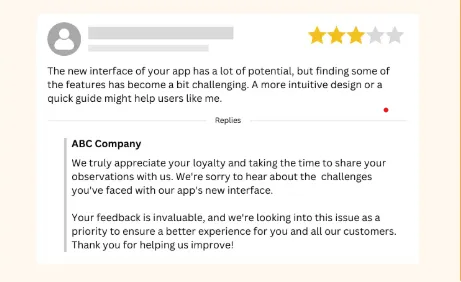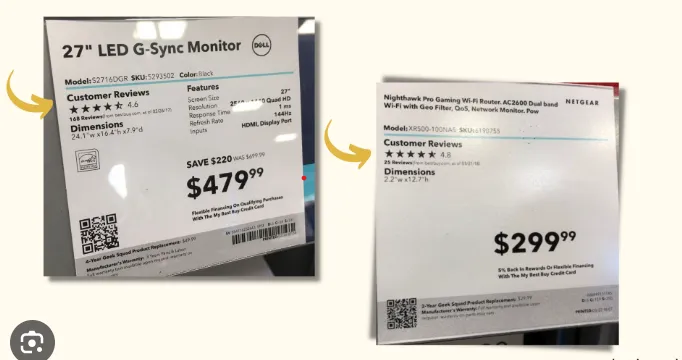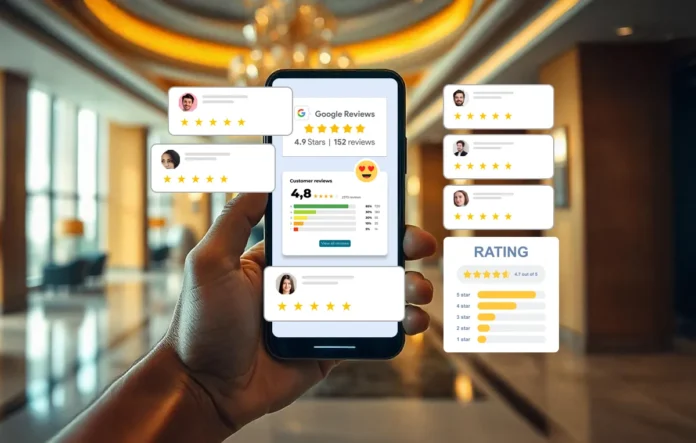For customers, your business is only as good as the reviews they find online.
“Your brand is what other people say about you when you’re not in the room.”
Jeff Bezos, Founder of Amazon
With the rise of review platforms like Google Business Profile, Yelp, and Facebook, reviews are now one of the most influential factors in customer decision-making.
In fact, 93% of consumers say online reviews impact their purchasing decisions.
Exactly! Reviews aren’t just opinions – they are the key success factor in the competitive market.
And the best part? You can actually shape the story your reviews tell.
But how? That’s what this guide is here for!
Whether you’re looking for strategies to get more positive feedback, tools to streamline the process, or tips on how to get started, we’ve got you covered.
Let’s begin with…
What Is Review Marketing?
Online review marketing is the strategy of leveraging customer feedback to enhance your brand’s reputation and attract more customers.
Essentially, it’s about actively seeking, managing, and showcasing positive reviews while constructively responding to the negative ones.
It creates a two-way conversation with your customers and turns that feedback into powerful marketing stories.
And most important, reviews give your brand a chance to tell its story from the customer’s perspective. They create social proof, build credibility, and, if managed well, can turn a satisfied customer into a long-term advocate.
The better you use them, the more trust and visibility your business gains!
Why Is Review Marketing Important?
We often think of marketing reviews as a way to boost sales and build brand trust, and that’s absolutely true.
But it also establishes a meaningful connection between brands and customers.
When done right, review marketing fosters a feedback loop that benefits both sides.
Here’s how:
1. Reviews as a Micro-Consulting Service
Instead of seeing reviews as simple feedback, think of them as free, highly targeted business insights.
Customers tell you what they love, what frustrates them, and what they wish existed. This feedback can directly fuel product improvements, service upgrades, and even new business opportunities.
“Your most unhappy customers are your greatest srource of learning.”
Bill Gates, Philanthropist and Founder of Microsoft


Example:
A clothing brand notices repeated reviews mentioning that their jeans have small pockets. Instead of just acknowledging the issue, they use that insight to redesign their jeans with deeper pockets, leading to happier customers and stronger sales.
Engaging with reviews (both positive and negative) isn’t just reputation management, it’s an opportunity to build a loyal community.
Personalized responses make customers feel valued, encourage brand advocacy, and show that their feedback truly matters to you.
For an example:
A software company sees a review mentioning confusion about a feature. Instead of just apologizing, they create a quick video tutorial explaining the feature and share it with the reviewer. Then, post it publicly, turning a frustrated user into a satisfied one while helping other potential customers.
3. Source of Hyper-Personalized Marketing
The words customers use in reviews can be a goldmine for marketing.
Instead of generic advertising, brands can craft campaigns using the exact language and emotions their customers express, making their messaging more relatable and effective.
For instance, an online bookstore notices that multiple reviews describe a thriller novel as “unputdownable” and “gripping.” They incorporate these exact words into their ad copy, instantly grabbing the attention of potential readers looking for a similar experience.


4. Boosts Search Engine Rankings
When it comes to local SEO, Google places a significant emphasis on reviews.
15% of all Google search results are related to local business information, and reviews play a big part in that ranking.
Google sees reviews as a sign that your business is active and engaging with customers, which can improve your visibility in local search results.
For instance, a company with consistently positive reviews will appear higher in local search rankings than a competitor with no reviews.
This means when someone searches for a service near them, your business is more likely to pop up if you have a solid review base.
5. Authentic Reviews Drive Higher Conversions
Did you know that businesses with ratings and reviews on product pages see a 120% increase in conversion rates?
Reviews influence purchasing decisions by providing social proof that your product or service delivers on its promises.
Think of it this way, would you rather buy a product with no reviews or one that has hundreds of positive reviews?
That’s why reviews are directly linked to higher conversion rates.
These are just a few powerful advantages of review marketing, but the impact goes even deeper.
To truly harness the power of reviews, you need a solid strategy in place. Let’s explore…
Proven Tactics for Successful Review Marketing
Building a successful marketing review strategy goes beyond just gathering reviews. It’s about using feedback as a powerful tool to shape your brand’s narrative, improve customer experience, and ultimately drive business growth.
With the right approach, review marketing can help establish trust, elevate brand reputation, and attract new customers.
Below is a breakdown of actionable, advanced strategies that will take your online review marketing to the next level.
A. Encouraging Customers to Leave Reviews
Apart from in-person review requests, you can follow the below methods to encourage customers to leave their experience with your business.
- Follow-up Emails/Text: After a purchase or service, send a polite follow-up message thanking your customers and requesting a review. Include direct links to your review platforms, making the process as simple as possible.
- Incentives: Offer small incentives like discounts, loyalty points, or exclusive content in exchange for leaving a review. Make sure to communicate that the incentive is for honest feedback (never ask for a 5-star rating or positive review).
- QR Codes: Place QR codes on receipts, business cards, or in-store displays that customers can scan easily to leave a review.


To take this one step further, you can sync the review generation tool with your CRM to automate review requests based on customer lifecycle stages which will increase the response rate significantly.
For example, you can set triggers for post-purchase reviews, service follow-ups, or long-term customer check-ins to gather feedback at relevant touchpoints.
Tip: Use A/B testing for review request templates to see which messages resonate better with your customers. Test variables like subject lines, messaging tone, timing, and channels (SMS vs. email) to optimize your review collection process.
Best Practices to Make the Process Seamless
- Make it Easy: Ensure the review process is quick and simple. A clear, direct link or one-click review option will encourage more customers to leave their feedback.
- Provide Guidance: Offer clear instructions on how to leave a review, especially for less tech-savvy customers.
B. Responding to All Types of Reviews
Always express gratitude for the positive feedback without any delay. Acknowledge the effort they took to leave a review and show appreciation for their loyalty.
What if they gave a negative review?
- Apologize: Acknowledge any mistakes and offer a sincere apology. Show that you care about the customer’s experience.
- Offer Solutions, Not Excuses: If any customer raises issues, address the complaint openly and offer a solution to the problem. Invite the reviewer to contact you directly to resolve any remaining concerns.
- Invite Them for a Second Chance: Offer a chance for the customer to revisit or try your product or service again, showing that you’re committed to improvement.


C. Showcasing Reviews in Marketing Campaigns
Here is how you can utilize reviews in product marketing campaigns:
1. Using Customer Reviews on Your Website & App
Incorporate positive customer reviews on key pages like your homepage or product/service pages to build trust and improve conversion rates.
Consider sharing your average rating, quotes, or review statistics on your website. Let your prospects see how many positive reviews you’ve collected and the product’s overall satisfaction score.
Transparency in your review scores makes customers feel more confident in your brand and products.
2. Incorporating Reviews in Email Campaigns
Many brands include glowing reviews or testimonials in their email newsletters, and you can do the same for your business. This encourages potential customers to trust the brand and also increases ROI.
3. Highlighting Reviews in Ads or Social Media Posts
Frequently, share reviews on your social media accounts to engage followers and build credibility. And incorporate reviews or ratings as part of your advertising campaigns to increase the effectiveness of your outreach.
Take it a step further, B2B businesses can transform positive reviews into detailed customer stories or case studies by collaborating with them. There’s nothing more persuasive than hearing success stories straight from the customers. An in-depth narrative of how your product or service solved a specific problem can be far more compelling to prospective customers than simple reviews alone
See how Imagine.io uses positive customer reviews to create case studies:


D. Leveraging Video Testimonials
Video reviews provide a personal touch that text-based reviews can’t match. They allow potential customers to see and hear real people sharing their experiences, leading to higher engagement.
How to Encourage Customers to Share Video Reviews
- Keep it Simple: Offer guidelines or prompts for customers on what to include in their video reviews, such as their favorite product features, how it solved their problem, or the most memorable aspect of their experience.
- Incentivize Video Reviews: Offer incentives like discounts, free trials, or even social media shout-outs for customers who submit video testimonials.
Tip: Apart from collecting video reviews from real customers, you can collaborate with industry experts or well-known figures to gather reviews. Their endorsements can lend credibility and attract a wider audience. Influencers add value as their reviews carry significant weight with their followers.
E. Monitoring and Analyzing Reviews
Monitoring customer feedback is an integral part of marketing reviews, as this helps you stay in tune with customer satisfaction, uncovering both strengths and weaknesses in your offerings.
You can spot recurring issues or highlights by analyzing review patterns, allowing you to adjust strategies accordingly.
Key Metrics to Monitor:
- Review Volume: Keep track of the number of reviews coming in to gauge overall engagement and customer interest.
- Rating Averages: Track changes in your average star rating over time to assess the impact of any actions taken to improve customer satisfaction.
- Sentiment Analysis: Use tools to analyze customer sentiment, ensuring that both positive and negative feedback is addressed promptly.
F. Expanding Review Marketing Beyond Online Platforms
Don’t limit review marketing to online campaigns. Incorporate customer testimonials and ratings in your print materials, business cards, LED displays, and flyers to create a cohesive message across all channels.


Additionally, for brick-and-mortar businesses, display positive reviews prominently within your store. Use signage or digital screens to showcase customer satisfaction and boost credibility in real time.
G. Reputation Auditing & Competitor Benchmarking
Periodic self-analysis is essential for any business, and reputation auditing (public perception assessment) plays a crucial role in this process. Regularly auditing your online reputation across all review platforms helps identify trends, uncover hidden issues, and address customer concerns before they escalate.
Additionally, competitor benchmarking is a powerful strategy. Various tools in the market allow businesses to compare their reviews against competitors by analyzing factors like review volume, sentiment, and response time.
By leveraging these insights, you can effectively refine your review strategy, capitalize on market gaps, and highlight your competitive advantages.
H. Using Review Management Tools
Review management tools take the hassle out of manually collecting and handling customer feedback. They automate review requests and follow-up via SMS and email, so you don’t have to chase customers for responses.
Everything is pulled into one centralized dashboard, making it easy to track, respond to, and analyze reviews from multiple platforms in one place.
Plus, with pre-built response templates and AI-powered insights, you can engage with customers faster and smarter.
The best part? They offer advanced analytics to help you spot trends and improve your strategy so your online reputation keeps growing effortlessly.
5 Best Tools for Review Marketing in 2025
Choosing the right review marketing tool can significantly impact your brand’s visibility and overall ratings. With so many options available, finding the perfect fit can be overwhelming.
But don’t worry; we’ve handpicked the five best tools to help you streamline your review marketing efforts.
Pick the software that aligns with your unique business needs:
A powerful review generation and management tool that automates the entire review marketing process.
With automated review requests and a centralized dashboard, businesses can easily monitor, collect, and respond to reviews from multiple platforms.
SocialPilot Reviews also offers white-label solutions, automated AI responses, real-time alerts, multi-location management, review widgets, and integrated social media scheduling, making it an all-in-one tool for businesses looking to strengthen their online reputation.
Best for small and mid-sized businesses, agencies, and multi-location brands seeking an affordable, feature-rich solution.
Podium
A messaging-first review marketing tool that simplifies customer interactions through text-based review requests. It enables businesses to send personalized review invitations via SMS, respond to feedback in real time, and improve customer engagement.
Best for local businesses, service providers, and healthcare professionals who want a direct and conversational way to collect reviews.
Trustpilot
A globally recognized review platform that collects and showcases customer feedback to build brand credibility.
With its substantial SEO benefits and integration options, Trustpilot helps businesses enhance their online presence and drive conversions through authentic reviews.
Best for e-commerce brands and online businesses that want to establish trust and transparency.
Google My Business (Google Reviews)
A must-have review platform for businesses to increase local search visibility and attract customers. By actively managing and responding to reviews on Google, companies can boost credibility and improve local SEO rankings.
Best for brick-and-mortar stores, restaurants, and service providers aiming to enhance their local reputation.
Birdeye
A comprehensive reputation and review marketing platform that automates review generation, sentiment analysis, and engagement.
It enables businesses to collect customer reviews from various sources, monitor brand sentiment, and showcase positive feedback across digital channels.
Best for multi-location businesses and enterprises that need an advanced, AI-powered solution for large-scale review management.
Common Mistakes to Avoid in Marketing Reviews
Even the best review marketing strategies can backfire if common mistakes go unnoticed. From mishandling negative feedback to buying fake reviews, these missteps can hurt your brand’s credibility.
Here are key pitfalls to avoid:
1. Buying Fake Reviews
It might seem tempting to purchase fake reviews to boost your ratings quickly, but it’s a risky move. Many review sites use advanced algorithms to detect inauthentic feedback, and getting caught can lead to penalties, removed reviews, or even account suspension.
More importantly, customers can usually spot fake reviews, which can damage brand image and credibility.
2. Ignoring Negative Feedback
No business is perfect, and receiving a negative review isn’t the end of the world. However, ignoring negative feedback can make your business seem unresponsive or uninterested in customer concerns.
Addressing complaints professionally, offering solutions, and showing a willingness to improve can turn a dissatisfied customer into a loyal one.
3. Overloading Customers with Review Requests
Asking for reviews is good, but overdoing it can irritate customers. If you send too many requests via email, SMS, or pop-ups, customers may start ignoring them or, worse, find it intrusive.
Instead, set up a strategic follow-up system that reminds customers at the right time without overwhelming them.
4. Focusing Only on Positive Reviews
While it’s great to showcase positive feedback, all-perfect review profiles in review marketing can seem suspicious. Customers value transparency, and seeing a mix of reviews, both glowing and constructive, makes your business appear more trustworthy.
The key is responding to all feedback and demonstrating how to handle concerns professionally.
5. Not Updating Profiles Across Review Platforms
Your business details like address, contact information, and hours—should always be accurate across review platforms. Outdated information can lead to lost sales and frustrated customers.
Make it a routine to check and update your profiles regularly on Google, Yelp, Facebook, and any niche-specific platforms.
6. Assuming Reviews Will Come Naturally
Many businesses believe that happy customers will automatically leave reviews, but in reality, most people need a nudge. If you’re not actively encouraging reviews, you could be missing out on valuable feedback.
A structured approach, such as automated requests, incentives, or in-person reminders, can help drive more organic reviews.
7. Not Leveraging Reviews for Marketing
To build credibility, positive reviews can be used in emails, social media posts, and advertisements. Failing to use these reviews for marketing means missing an opportunity to connect with new customers.
How to Get Started with Review Marketing (Funnel)
Getting started with review marketing doesn’t have to be overwhelming. By following these key steps, businesses can create a structured approach to collecting, managing, and leveraging customer reviews for growth.
Here is how to do it step by step:
- Identify the Right Review Platforms: Determine which platforms matter most in your industry. Google Reviews, Yelp, Trustpilot, and Facebook are great general options, but niche-specific sites like Zillow (real estate) or G2 (software) may be crucial for your business.
- Claim & Optimize Your Business Profiles: Ensure your business is listed on all relevant review sites with complete, up-to-date information. Add high-quality images, descriptions, contact details, and branding elements to establish credibility.
- Set Up an Automated Review Collection System: Use review management tools to send automated SMS and email review requests. Timing is key—trigger requests right after a purchase or service completion to maximize response rates. This is the most important step in any review marketing strategy.
- Make It Easy for Customers to Leave Reviews: Provide direct links to review pages via email, SMS, QR codes, and even website pop-ups. Remove unnecessary steps and make the process as seamless as possible.
- Train Your Team on Review Engagement: Equip customer support and sales teams with best practices for requesting reviews, responding professionally, and handling negative feedback effectively. A well-trained team can turn even unhappy customers into loyal advocates.
- Create a Review Response Strategy: Develop templates and guidelines for responding to both positive and negative reviews. Personalize responses to show authenticity, thank customers for feedback, and address any concerns professionally.
- Monitor & Analyze Review Performance: Regularly track review volume, sentiment trends, and star ratings using analytics tools. Use these insights to improve customer experience and address recurring issues.
- Leverage Reviews in Marketing: Showcase top reviews on your website, social media, and marketing materials. Video testimonials and customer stories can add even more impact.
- Encourage Ongoing Customer Feedback: Keep the momentum going by integrating review requests into your customer journey. Offer incentives (like discounts or loyalty points) while maintaining ethical review practices.
- Continuously Optimize Your Review Strategy: Adapt your approach based on insights. Test different request timing, platforms, and messaging styles to see what works best for your audience.
Conclusion
A strong online review marketing strategy isn’t a one-time effort—it’s an ongoing process that builds brand trust, credibility, and long-term business growth.
By implementing the mentioned review marketing strategies and leveraging SocialPilot’s AI automation features while avoiding common mistakes, businesses can turn customer reviews into a powerful, long-term asset for driving growth across all marketing channels.
Start small, refine your approach, and watch your online reputation thrive!

